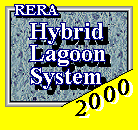
COPYRIGHTS
1999-2009 RERA
All right reserved.
Any Unauthorized
Copying
or Using Prohibited.
Preface
Table
of Contents
Foundation
Hybrid
Lagoon System
Case
Study
Applications
Proposals
6. Survey of Circulating Waterway (OD) Facilities Functions, 1974-1976.
Drawbacks and Technical Problems Related to Circulating Waterway (OD) Facilities.
The first facilities for LLSB activated sludge treatment (LLSBAS, circulating waterway type) were constructed in 1974 for processing liquid waste from livestock and hog raising at the Tsuga Farm in Tochigi Prefecture. Upon conducting a survey of the operation of these facilities over several years, the following facts were discovered. (See text, 349 and beyond).
BOD, COD removal functions were highly satisfactory.
The organic denitrification function reached 99%“ efficiency (no carbon source was required) .
An organic dephosphorization efficiency of 70%“ may be expected.
Non-diluted treatment of highly concentrated wastewater (with a BOD of l0, 000 mg/liter or so) is possible.
Generation of excess sludge is less than one-half that for the standard activated sludge method.
There is little seasonal variation, and denitrification was verified to take place even in winter (water temperature 5 C).
The above survey of facility operation demonstrated that circulating waterway (OD) facilities have a simple construction, entail low construction expenses, and provide excellent denitrification functions. On the other hand, a number of technical difficulties remain:
When using mechanical surface aerating techniques, it is difficult to make the effective water depth in the reaction basin deep; hence the land area required for facility construction is large.
In circulating waterway facilities, considerable motion is necessary to achieve complete mixing.
Excessive aeration and excessive amounts of oxygen tend to hinder the denitrification process.
Consequently, it was concluded that for application of the LLSB activated sludge method, development of basin shapes, aeration techniques and methods for controlling the amount of? Aerated liquid motion, suitable for non-continuous operation, is essential.